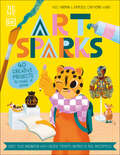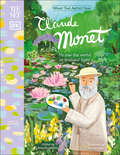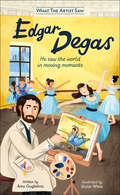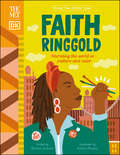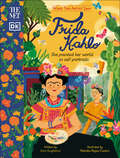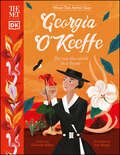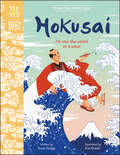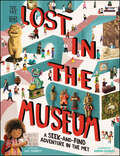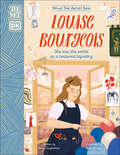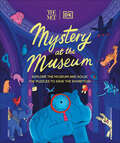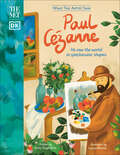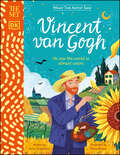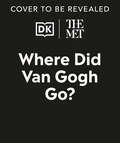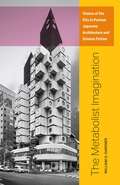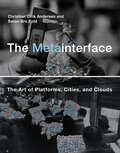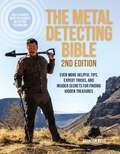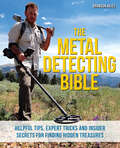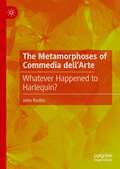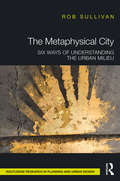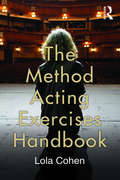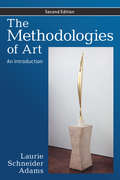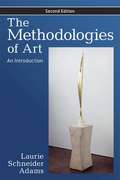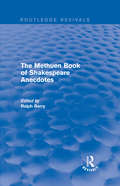- Table View
- List View
The Met 5000 Years of Awesome Objects: A History of Art for Children (DK The Met)
by Aaron Rosen Susie Hodge Susie Brooks Mary RichardsImagine having 5,000 of human history&’s most amazing artefacts at your fingertips!Go on a trip through the famous Metropolitan Museum of Art without ever leaving your home! Prepare to explore the treasures of the world&’s civilizations—from ancient Egyptian amulets, Mayan jewelry, and prehistoric tools—to Medieval tapestries, Renaissance suits of armor, and modern-day baseball cards. Each page brings you closer to the past as you learn about the people of different ages through the objects they left behind. Discover hand-picked highlights of the museum&’s huge collection as you travel through history, one incredible object at a time.This book combines exclusive Met photography with colorful and quirky illustrations in a resource that parents can trust, with a design that kids will love. © The Metropolitan Museum of Art, New York
The Met Art Sparks: Ignite Your Imagination with Creative Prompts Inspired by Real Masterpieces (DK The Met)
by Alice HarmanDiscover incredible artworks and find your inspiration in The Metropolitan Museum of Art! Cut, stick, paint and draw with these awesomely arty activities inspired by real masterpieces. An artistic cheetah leads you through the museum as you explore and discover amazing pieces from The Met. Follow the prompts to create your own works of art! Turn your hand to artistic techniques like pointillism and sgraffito and have a go at making clay sculptures and relief prints. With space for you to try out each idea and amazing facts to read, you&’ll find all the inspiration you need to make art and have fun.
The Met Claude Monet: He Saw the World in Brilliant Light (What the Artist Saw)
by Amy GuglielmoSee how iconic artists like Claude Monet were influenced by their environments in this beautiful series produced in collaboration with The Met.See the world through Claude Monet&’s&’ eyes and be inspired to produce your own masterpieces. Have you ever wondered exactly what your favorite artists were looking at to make them draw, sculpt, or paint the way they did? In this charming illustrated series of books to keep and collect, created in full collaboration with the Metropolitan Museum of Art, you can see what they saw and be inspired to create your own artwork, too. In What the Artist Saw: Claude Monet, meet famous French painter Claude Monet. Step into his life and learn how he pioneered the Impressionist movement. Learn all about his love of nature and how he was inspired to paint light, water, and water lilies. Have a go at producing your own art inspired by what you find most beautiful about nature! In this series, follow the artists&’ stories and find intriguing facts about their environments and key masterpieces. Then see what you can see and make your own art. Take a closer look at landscapes, or even yourself, with Vincent van Gogh. Try crafting a story in fabric like Faith Ringgold, or carve a woodblock print at home with Hokusai. Every book in this series is one to treasure and keep— perfect for budding young artists to explore exhibitions with, then continue their own artistic journeys.
The Met Edgar Degas: He Saw the World in Moving Moments (What the Artist Saw)
by Amy GuglielmoSee how iconic artists like Edgar Degas were influenced by their environments in this beautiful series produced in collaboration with The Met.See the world through Edgar Degas&’s eyes and be inspired to produce your own masterpieces.Have you ever wondered exactly what your favorite artists were looking at to make them draw, sculpt, or paint the way they did? In this charming illustrated series of books to keep and collect, created in full collaboration with The Metropolitan Museum of Art, you can see what they saw, and be inspired to create your own artworks, too. In What the Artist Saw: Edgar Degas, meet the famous French painter and sculptor. Learn all about how he broke new ground and captured the energy and elegance of skilled ballet dancers.In this series, follow the artists&’ stories and find intriguing facts about their environments and key masterpieces. Then see what you can see and make your own art. Take a closer look at landscapes, or even yourself, with Vincent van Gogh. Try crafting a story in fabric like Faith Ringgold, or carve a woodblock print at home with Hokusai. Every book in this series is one to treasure and keep—perfect for budding young artists to explore exhibitions with then continue their own artistic journeys.
The Met Faith Ringgold: Narrating the World in Pattern and Color (What the Artist Saw)
by Sharna JacksonSee the world through Faith Ringgold's eyes and be inspired to produce your own masterpieces.Have you ever wondered exactly what your favorite artists were looking at to make them draw, sculpt, or paint the way they did? In this charming illustrated series of books to keep and collect, created in full collaboration with the Metropolitan Museum of Art, you can see what they saw, and be inspired to create your own artworks, too. In What the Artist Saw: Faith Ringgold, meet inspiring American activist Faith Ringgold. Step into her life and learn what led her to mix different media and craft powerful stories into quilts. Travel with her from Harlem, New York, to Europe, Ghana, and Nigeria. Pick a cause that you care about and try combining it with fabric or sculpture to make your own artworks! In this series, follow the artists' stories and find intriguing facts about their environments and key masterpieces. Then see what you can see and make your own art. Take a closer look at landscapes with Georgia O'Keeffe, or even yourself, with Vincent van Gogh. Try carving a woodblock print at home with Hokusai. Every book in this series is one to treasure and keep: perfect for budding young artists to explore exhibitions with, and then continue their own artistic journeys.
The Met Frida Kahlo: She Painted Her World in Self-Portraits (What the Artist Saw)
by Amy GuglielmoSee the world through Frida Kahlo's eyes and be inspired to produce your own masterpieces.Have you ever wondered exactly what your favorite artists were looking at to make them draw, sculpt, or paint the way they did? In this charming illustrated series of books to keep and collect, created in full collaboration with The Metropolitan Museum of Art, you can see what they saw, and be inspired to create your own artworks, too. In What the Artist Saw: Frida Kahlo, meet the famous Mexican painter. Learn all about how she experimented with different ways of painting herself, and how she channeled her experiences into her art. Have a go at producing your own self portrait!In this series, follow the artists' stories and find intriguing facts about their environments and key masterpieces. Then see what you can see and make your own art. Take a closer look at landscapes, or even yourself, with Vincent van Gogh. Try crafting a story in fabric like Faith Ringgold, or carve a woodblock print at home with Hokusai. Every book in this series is one to treasure and keep - perfect for budding young artists to explore exhibitions with, then continue their own artistic journeys.© The Metropolitan Museum of Art, New York
The Met Georgia O'Keeffe: She saw the world in a flower (What the Artist Saw)
by Gabrielle BalkanSee the world through Georgia O'Keeffe's eyes and be inspired to produce your own masterpieces.Have you ever wondered exactly what your favorite artists were looking at to make them draw, sculpt, or paint the way they did? In this charming illustrated series of books to keep and collect, created in full collaboration with the Metropolitan Museum of Art, you can see what they saw, and be inspired to create your own artworks, too. In What the Artist Saw: Georgia O'Keeffe, meet famous American painter Georgia O'Keeffe. Step into her life and learn what led her to look closely at nature and paint her iconic paintings of flowers and bones. See the vast New Mexico landscapes that inspired her work. Have a go at producing your own close-up still-life artworks! Follow the artists' stories and find intriguing facts about their environments and key masterpieces. Then see what you can see and make your own art. Take a closer look at landscapes, or even yourself, with Vincent van Gogh. Try crafting a story in fabric like Faith Ringgold, or carve a woodblock print at home with Hokusai. Every book in this series is one to treasure and keep - perfect for budding young artists to explore exhibitions with, then continue their own artistic journeys. © The Metropolitan Museum of Art, New York
The Met Hokusai: He Saw the World in a Wave (What the Artist Saw)
by Susie HodgeSee the world through Hokusai's eyes and be inspired to produce your own masterpieces.Have you ever wondered exactly what your favorite artists were looking at to make them draw, sculpt, or paint the way they did? In this charming illustrated series of books to keep and collect, created in full collaboration with The Metropolitan Museum of Art, you can see what they saw, and be inspired to create your own artworks, too. In What the Artist Saw: Hokusai, meet groundbreaking Japanese artist Hokusai. Step into his life and learn what led him to create more than 30,000 works of art, including his famous woodcut views of The Great Wave off Kanagawa and Mount Fuji. Discover how he planned to live to 110 and even produced the first ever pieces of manga! Have a go at making your own printed artworks. In this series, follow the artists&’ stories and find intriguing facts about their environments and key masterpieces. Then see what you can see and make your own art. Take a closer look at landscapes with Georgia O&’Keeffe, or even yourself, with Vincent van Gogh. Every book in this series is one to treasure and keep – perfect for inspiring budding young artists to continue their own artistic journeys. © The Metropolitan Museum of Art, New York
The Met Lost in the Museum: A seek-and-find adventure in The Met (DK The Met)
by Will MabbittA visually stunning seek-and-find museum adventure for inquisitive kids.Seven-year-old Stevie is lost in the galleries! She needs to locate a series of artworks to find her way out and back to her family. Can you help her? Follow Stevie as she explores the most exciting and intriguing galleries and exhibitions inside The Met in this beautifully illustrated seek-and-find adventure!As Stevie moves through The Met's galleries of Greek and Roman art, Ancient Egypt, and Modern and Contemporary art, learn about the rarest and most beautiful objects found in the museum's prestigious galleries. Who can you find? What will you discover?© The Metropolitan Museum of Art, New York
The Met Louise Bourgeois: She Saw the World as a Textured Tapestry (What the Artist Saw)
by Amy GuglielmoSee how iconic artists like Louise Bourgeois were influenced by their environments in this beautiful series produced in collaboration with The Met.See the world through Louise Bourgeois&’s eyes and be inspired to produce your own masterpieces. Have you ever wondered exactly what your favorite artists were looking at to make them draw, sculpt, or paint the way they did? In this charming illustrated series of books to keep and collect, created in full collaboration with the Metropolitan Museum of Art, you can see what they saw and be inspired to create your own artworks too. In What the Artist Saw: Louise Bourgeois, meet famous French American painter, printmaker, and sculptor Louise Bourgeois. Step into her life and learn what led her to explore her fears and emotions through her art. Learn all about her family and what inspired her to create her large spider sculptures. Have a go at producing your own art inspired by your dreams! In this series, follow the artists&’ stories and find intriguing facts about their environments and key masterpieces. Then see what you can see and make your own art. Take a closer look at landscapes, or even yourself, with Vincent van Gogh. Try crafting a story in fabric like Faith Ringgold, or carve a woodblock print at home with Hokusai. Every book in this series is one to treasure and keep— perfect for budding young artists to explore exhibitions with, then continue their own artistic journeys.
The Met Mystery at the Museum: Explore the Museum and Solve the Puzzles to Save the Exhibition! (DK The Met)
by Helen FrielJoin William the hippo and friends in an interactive adventure puzzle book. Help them solve the mystery and save the exhibition!William the hippo and his friends live on 5th Avenue, New York, inside the Metropolitan Museum of Art. At night, when the museum is closed and all the visitors have gone home, their adventures begin. A special exhibition is about to open, and everyone is excited to see the amazing exhibits from all over the world. However, the boxes holding the exhibits are locked with puzzles that need to be solved. The curators are struggling to figure them out - it's up to you to help William and his friends travel through the museum, solve the puzzles, and save the exhibition!
The Met Paul Cézanne (What the Artist Saw)
by Amy GuglielmoSee the world through Paul Cézanne's eyes and be inspired to produce your own masterpieces.Have you ever wondered exactly what your favorite artists were looking at to make them draw, sculpt, or paint the way they did? In this charming illustrated series of books to keep and collect, created in full collaboration with The Metropolitan Museum of Art, you can see what they saw and be inspired to create your own artworks, too. In What the Artist Saw: Paul Cézanne meet the famous French painter. In this series, follow the artists' stories and find intriguing facts about their environments and key masterpieces. Then see what you can see and make your own art. Take a closer look at landscapes, or even yourself, with Vincent van Gogh. Try crafting a story in fabric like Faith Ringgold, or carve a woodblock print at home with Hokusai. Every book in this series is one to treasure and keep-perfect for budding young artists to explore exhibitions with, then continue their own artistic journeys.
The Met Vincent van Gogh: He saw the world in vibrant colors (What the Artist Saw)
by Amy GuglielmoSee the world through Vincent van Gogh's eyes and be inspired to produce your own masterpieces.Have you ever wondered exactly what your favorite artists were looking at to make them draw, sculpt, or paint the way they did? In this charming illustrated series, created in full collaboration with the Metropolitan Museum of Art, you can see what they saw, and be inspired to create your own artworks, too. In the pages of this book, What the Artist Saw: Vincent van Gogh, meet famous Dutch painter Vincent van Gogh. Step into his life and learn what led him to paint his eye-catching self-portraits. See the landscapes that inspired his famous Wheat Fields. Have a go at painting your own sunflowers! Follow the artists' stories and find intriguing facts about their environments and key masterpieces. Then see what you can see and make your own art. Take a closer look at nature with Georgia O'Keeffe. Try crafting a story in fabric like Faith Ringgold, or carve a woodblock print at home with Hokusai. Every book in this series is one to treasure and keep - the perfect gift for budding artists to explore exhibitions with, then continue their own artistic journeys. © The Metropolitan Museum of Art, New York
The Met Where Did Van Gogh Go? (DK The Met)
by DKLose yourself in scenes inspired by the creative genius of Vincent Van Gogh, Georgia O’Keeffe, Hokusai, James Van Der Zee, and many more!Do you want to roam through a field of swaying cypress trees hunting for Vincent Van Gogh’s paintbrush? Or explore Georgia O’Keeffe’s New Mexico ranch on the lookout for wildflowers? Perhaps you’d rather navigate the waterways of Canaletto’s Venice to find decorative masks?Discover unique scenes inspired by some of The Metropolitan Museum of Art’s most loved paintings and the lives of their creators. Read about the artist and their work before embarking on a fun seek-and-find activity inspired by the artist’s life.Perfect for fans of Where’s Waldo? and Pierre the Maze Detective, Where Did Van Gogh Go? is the arty spotting book that little kids and big kids alike can enjoy.
The Metabolist Imagination: Visions of the City in Postwar Japanese Architecture and Science Fiction
by William O. GardnerJapan&’s postwar urban imagination through the Metabolism architecture movement and visionary science fiction authors The devastation of the Second World War gave rise to imaginations both utopian and apocalyptic. In Japan, a fascinating confluence of architects and science fiction writers took advantage of this space to begin remaking urban design. In The Metabolist Imagination, William O. Gardner explores the unique Metabolism movement, which allied with science fiction authors to foresee the global cities that would emerge in the postwar era.This first comparative study of postwar Japanese architecture and science fiction builds on the resurgence of interest in Metabolist architecture while establishing new directions for exploration. Gardner focuses on how these innovators created unique versions of shared concepts—including futurity, megastructures, capsules, and cybercities—making lasting contributions that resonate with contemporary conversations around cyberpunk, climate change, anime, and more.The Metabolist Imagination features original documentation of collaborations between giants of postwar Japanese art and architecture, such as the landmark 1970 Osaka Expo. It also provides the most sustained English-language discussion to date of the work of Komatsu Sakyō, considered one of the &“big three&” authors of postwar Japanese science fiction. These studies are underscored by Gardner&’s insightful approach—treating architecture as a form of speculative fiction while positioning science fiction as an intervention into urban design—making it a necessary read for today&’s visionaries.
The Metainterface: The Art of Platforms, Cities, and Clouds (The\mit Press Ser.)
by Christian Ulrik Andersen Soren Bro PoldHow the interface has moved from the PC into cultural platforms, as seen in a series of works of net art, software art and electronic literature.The computer interface is both omnipresent and invisible, at once embedded in everyday objects and characterized by hidden exchanges of information between objects. The interface has moved from office into culture, with devices, apps, the cloud, and data streams as new cultural platforms. In The Metainterface, Christian Ulrik Andersen and Søren Bro Pold examine the relationships between art and interfaces, tracing the interface's disruption of everyday cultural practices. They present a new interface paradigm of cloud services, smartphones, and data capture, and examine how particular art forms—including net art, software art, and electronic literature—seek to reflect and explore this paradigm.Andersen and Pold argue that despite attempts to make the interface disappear into smooth access and smart interaction, it gradually resurfaces; there is a metainterface to the displaced interface. Art can help us see this; the interface can be an important outlet for aesthetic critique. Andersen and Pold describe the “semantic capitalism” of a metainterface industry that captures user behavior; the metainterface industry's disruption of everyday urban life, changing how the city is read, inhabited, and organized; the ways that the material displacement of the cloud affects the experience of the interface; and the potential of designing with an awareness of the language and grammar of interfaces.
The Metal Detecting Bible, 2nd Edition: Even More Helpful Tips, Expert Tricks, and Insider Secrets for Finding Hidden Treasures (Fully Updated with the Newest Detecting Technology)
by Brandon NeiceStart your metal detecting journey or improve your treasure-hunting skills with this expert guide that teaches you everything from choosing between VLF, pulse induction, full band, or zero-voltage transmission detectors to identifying rare finds.Nothing is as thrilling as finding cool (and often valuable) stuff right under your feet. The Metal Detecting Bible, 2nd Edition serves up step-by-step instructions, illustrations, and useful photos that can turn you into a professional treasure hunter in no time. From quick-start tips for novices to insider secrets for the most experienced hobbyists, this hands-on guide is the ultimate resource on all aspects of metal detecting. Now, in this fully-updated edition, make your search even more successful and exciting with the latest information on: Choosing the best metal detector Learning where to search and why Practicing appropriate swing techniques Integrating advanced GPS technology Scouting out beaches, parks, and historic sites Gaining permission to hunt on private property Identifying antique coins, relics, and jewelry Using handy target recovery tools Cleaning and safely preserving your finds Selling your finds for a profit And more! So grab this guide and get ready to dig up more fascinating finds!
The Metal Detecting Bible: Helpful Tips, Expert Tricks And Insider Secrets For Finding Hidden Treasures
by Brandon NeiceTHE ULTIMATE A-TO-Z GUIDE REVEALING EVERYTHING YOU NEED TO KNOW TO BECOME A METAL DETECTING EXPERT Nothing is as thrilling as finding cool (and often valuable) stuff right under your feet. So grab this guide and get ready to dig up more and more finds. Packed with helpful information on making your search successful and exciting, The Metal Detecting Bible serves up step-by-step instructions, illustrations, and useful photos that can turn you into a professional treasure hunter. From quick-start tips for novices to insider secrets for the most experienced hobbyists, this hands-on guide is the ultimate resource on all aspects of metal detecting. *Choose the best metal detector *Learn where to search and why *Practice appropriate swing techniques *Integrate advanced GPS technology *Scout out beaches, parks and historic sites *Gain permission to hunt on private property *Identify antique coins, relics and jewelry *Use handy target recovery tools *Clean and safely preserve your finds *Sell your finds for a profit
The Metallurgy of Roman Silver Coinage
by Kevin Butcher Jane Evans Vanessa Pashley Matthew Ponting Christopher Somerfield Kevin Butcher Matthew Ponting Jane Evans Vanessa Pashley Christopher SomerfieldThe fineness of Roman imperial and provincial coinage has been regarded as an indicator of the broader fiscal health of the Roman Empire, with the apparent gradual decline of the silver content being treated as evidence for worsening deficits and the contraction of the supply of natural resources from which the coins were made. This book explores the composition of Roman silver coinage of the first century AD, re-examining traditional interpretations in the light of an entirely new programme of analyses of the coins, which illustrates the inadequacy of many earlier analytical projects. It provides new evidence for the supply of materials and refining and minting technology. It can even pinpoint likely episodes of recycling old coins and, when combined with the study of hoards, hints at possible strategies of stockpiling of metal. The creation of reserves bears directly on the question of the adequacy of revenues and fiscal health.
The Metamorphoses of Commedia dell’Arte: Whatever Happened to Harlequin?
by John RudlinThe Metamorphoses of Commedia dell’Arte traces the steps by which Commedia has been transformed by cultural contact outside Italy into popular forms which bear little resemblance to the original. The book follows the Masks of Arlecchino, Pedrolino and Pulcinella as they gradually migrate and mutate into Harlequin, Mr. Punch and seaside Pierrot troupes. What happened to Pantalone, Scaramouche, Colombina and the male Lover is also investigated, though they had no final forms of their own. This study constitutes a history of what happened, notably in France and Great Britain, to a supremely popular theatrical genre as a result of changing fashions in entertainment brought on by societal developments, civil and industrial revolution and dynastic change. It investigates how the genre was exploited by management, and even its own stars, lost its vitality and gradually ended up in ‘sunken’ forms.
The Metaphysical City: Six Ways of Understanding the Urban Milieu
by Rob SullivanThe Metaphysical City examines the metaphorical existence of the city as an entity to further understand its significance on urban planning and geography. It encourages an open-minded approach when studying cities so as to uncover broader connecting themes that may otherwise be missed. Case studies of New York, Paris, Cairo, Mumbai, Tokyo, and Los Angeles explore a metaphor specific to each city. This multidisciplinary analysis uses philosophical treatises, geographical analysis, and comparative literature to uncover how each city corresponds to the metaphor. As such, it allows the reader to understand the city from six differing points of view. This book would be beneficial to students and academics of urban planning, geography, and comparative literature, in particular those with an interest in a metaphysical examination of cities.
The Method Acting Exercises Handbook
by Lola CohenThe Method Acting Exercises Handbook is a concise and practical guide to the acting exercises originally devised by Lee Strasberg, one of the Method's foremost practitioners. The Method trains the imagination, concentration, senses and emotions to ‘re-create’ – not ‘imitate’ – logical, believable and truthful behavior on stage and in film. Building on nearly 30 years of teaching internationally and at the Lee Strasberg Theatre and Film Institute in New York and Los Angeles, Lola Cohen details a series of specific exercises in order to provide clear instruction and guidance to this preeminent form of actor training. By integrating Strasberg's voice with her own tried and tested style of teaching, Cohen demonstrates what can be gained from the exercises, how they can inform and inspire your learning, and how they might be applied to your acting and directing practice. As a companion to The Lee Strasberg Notes (Routledge 2010), a transcription of Strasberg's own teaching, The Method Acting Exercises Handbook offers an unparalleled and updated guide to this world renowned technique.
The Methodologies of Art: An Introduction
by Laurie Schneider AdamsSince the nineteenth century, when art history became an established academic discipline, works of art have been ?read? in a variety of ways. These different ways of describing and interpreting art are the methodologies of artistic analysis, the divining rods of meaning. Regardless of a work's perceived difficulty, an art object is, in theory, complex. Every work of art is an expression of its culture (time and place) and its maker (the artist) and is dependent on its media (what it's made of). The methodologies discussed here?formal analysis, iconology and iconography, Marxism, feminism, biography and autobiography, psychoanalysis, structuralism, race and gender?reflect the multiplicity of meanings in an artistic image. The second edition includes nineteen new images, new sections on race, gender, orientalism, and colonialism, and a new epilogue that analyzes a single painting to illustrate the different methodological viewpoints.
The Methodologies of Art: An Introduction (Second Edition)
by Laurie Schneider AdamsSince the nineteenth century, when art history became an established academic discipline, works of art have been "read" in a variety of ways. These different ways of describing and interpreting art are the methodologies of artistic analysis, the divining rods of meaning. Regardless of a work's perceived difficulty, an art object is, in theory, complex. Every work of art is an expression of its culture (time and place) and its maker (the artist) and is dependent on its media(what it's made of). The methodologies discussed here-formal analysis, iconology and iconography, Marxism, feminism, biography and autobiography, psychoanalysis, structuralism, race and gender-reflect the multiplicity of meanings in an artistic image. The second edition includes nineteen new images, new sections on race, gender, orientalism, and colonialism, and a new epilogue that analyzes a single painting to illustrate the different methodological viewpoints.
The Methuen Book of Shakespeare Anecdotes
by Ralph BerryFew playwrights have been more slandered, abused or honoured in performance than William Shakespeare. First published in 1992, this collection of 300 stories focuses on Shakespeare’s plays on stage. Organised chronologically, it offers the reader the opportunity to witness the changes in theatrical approaches to Shakespeare from their own time to the present day. This book will be of interest to those studying theatre, but also to those fascinated by the Shakespeare tradition.

